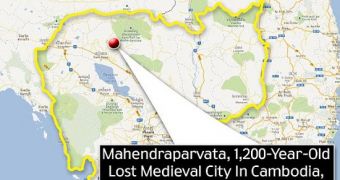An ancient city estimated to have been built some 1,200 years ago has recently been discovered by a team of Australian archaeologists.
Commenting on their findings, the archaeologists explain that the city of Mahendraparvata has spent the past millennium hidden beneath the forests towering over Cambodia's Siem Reap region.
Mahendraparvata rests atop a mountain known as Phnom Kulen. Specialists suspect that it was one of the Khmer Empire's first city, sources report.
Presently, the researchers have only managed to pin down some temples, canals, roads, caves and mounds they assume are tombs. The Verge says that, since the jungle surrounding this ancient city is fairly thick, there are high chances that what the archaeologists have thus far uncovered is just one small portion of the city.
What's more, it is possible that Mahendraparvata's central part is yet to be discovered and documented.
“Maybe what we are seeing was not the central part of the city. So there is a lot of work to be done to discover the extent of this civilization,” archaeologist Damian Evans reportedly told the press.
What is interesting is that this long-lost city was found with the help of remote sensing technology. To put it in a nutshell, lasers were used to piece together a detailed map of this forested area of Cambodia.
“With this instrument - bang - all of a sudden we saw an immediate picture of an entire city that no one knew existed which is just remarkable,” Damian Evans said.
The map allowed the researchers to identify the location of two ancient temples and a cave whose walls were found to be covered in centuries-old carvings.
After they set out to explore the area by foot, the researchers found several other temples and evidence suggesting that canals and roads crisscrossed Cambodia's Siem Reap region more than 1,000 years ago.
The city of Mahendraparvata rests at a distance of just 25 miles (40.23 kilometers) west of Angkor Wat, the world's largest religious monument.
Some say that it predates this Hindu temple complex by 350 years.

 14 DAY TRIAL //
14 DAY TRIAL //